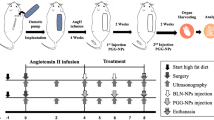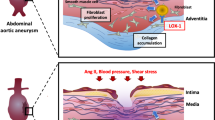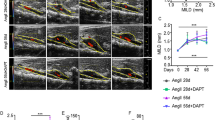Abstract
Vessel wall inflammation and matrix destruction are critical to abdominal aortic aneurysm (AAA) formation and rupture. We have previously shown that urokinase plasminogen activator (uPA) is highly expressed in experimental AAA and is essential for AAA formation and expansion. In this study, we examined the effects of overexpression of a natural inhibitor of uPA, plasminogen activator inhibitor-1 (PAI-1), on the development of angiotensin (Ang) II-induced AAA in ApoE-deficient (ApoE−/−) mice. Mice were treated with recombinant adenovirus containing either the human PAI-1 gene (Ad5.CMV.PAI-1) or the luciferase gene (Ad5.CMV.Luc) delivered either locally by intra-adventitial injection or systemically by tail vein injection. Our results show that local delivery of the PAI-1 gene completely prevented AAA formation (0 vs 55.6% in Ad5.CMV.Luc controls, P<0.05). In contrast, systemic delivery of the PAI-1 gene did not affect AAA incidence (78 vs 90% in Ad5.CMV.Luc controls, P=0.125). Local delivery of the PAI-1 gene 2 weeks after Ang II infusion prevented further expansion of small aneurysms, but had no significant effect on the progression of larger aneurysms. These data suggest that local PAI-1 gene transfer could be used to stabilize small AAA and reduce the rate of expansion and risk of rupture.
This is a preview of subscription content, access via your institution
Access options
Subscribe to this journal
Receive 12 print issues and online access
$259.00 per year
only $21.58 per issue
Buy this article
- Purchase on Springer Link
- Instant access to full article PDF
Prices may be subject to local taxes which are calculated during checkout








Similar content being viewed by others
References
Shah PK . Inflammation, metalloproteinases, and increased proteolysis: an emerging pathophysiological paradigm in aortic aneurysm. Circulation 1997; 96: 2115–2117.
Grange JJ, Davis V, Baxter BT . Pathogenesis of abdominal aortic aneurysm: update and look toward the future. Cardiovasc Surg 1997; 5: 256–265.
Thompson RW . Basic science of abdominal aortic aneurysms: emerging therapeutic strategies for an unresolved clinical problem. Curr Opin Cardiol 1996; 11: 504–518.
Wang YX, Martin-McNulty B, Freay AD, Sukovich DA, Halks-Miller M, Vergona R et al. Angiotensin II increases urokinase-type plasminogen activator expression and induces aneurysm in the abdominal aorta of apolipoprotein E-deficient mice. Am J Pathol 2001; 159: 1455–1464.
Deng GG, Martin-McNulty B, Sukovich DA, Freay A, Halks-Miller M, Thinnes T et al. Urokinase-type plasminogen activator plays a critical role in angiotensin II-induced abdominal aortic aneurysm. Circ Res 2003; 92: 510–517.
Koch AE, Haines GK, Rizzo RJ, Radosevich JA, Pope RM, Robinson PG et al. Human abdominal aortic aneurysms. Immunophenotypic analysis suggesting an immune-mediated response. Am J Pathol 1990; 137: 1199–1213.
Koch AE, Kuukel SL, Pearce WH, Shah MR, Parikh D, Evanoff HL et al. Enhanced production of the chemotactic cytokines interleukin-8 and monocyte chemoattractant protein-1 in human abdominal aortic aneurysms. Am J Pathol 1993; 142: 1423–1431.
Manning MW, Cassi LA, Huang J, Szilvassy SJ, Daugherty A . Abdominal aortic aneurysms: fresh insights from a novel animal model of he disease. Vasc Med 2002; 7: 45–54.
Jonasson L, Holm J, Skalli O, Bondjers G, Hansson GK . Regional accumulations of T cells, macrophages, and smooth muscle cells in the human atherosclerotic plaque. Arteriosclerosis 1986; 6: 131–138.
Ross R . Atherosclerosis—an inflammatory disease. New Engl J Med 1999; 340: 115–126.
Carmeliet P, Moons L, Lijnen R, Baes M, Lemaître V, Tipping P et al. Urokinase-generated plasmin activates matrix metalloproteinases during aneurysm formation. Nat Genet 1997; 17: 439–444.
Hayek T, Attias J, Smith J, Breslow JL, Keidar S . Antiatherosclerotic and antioxidative effects of captopril in apolipoprotein E-deficient mice. J Cardiovasc Pharmacol 1998; 31: 540–544.
Daugherty A, Manning MW, Cassis LA . Angiotensin II promotes atherosclerotic lesions and aneurysms in apolipoprotein E-deficient mice. J Clin Invest 2000; 105: 1605–1612.
Blasi F . uPA, uPAR, PAI-1: key intersection of proteolytic, adhesive and chemotactic highways? Immunol Today 1997; 18: 415–417.
Nykjaer A, Conese M, Christensen EI, Olson D, Cremona O, Gliemann J et al. Recycling of the urokinase receptor upon internalization of the uPA: serpin complexes. EMBO J 1997; 16: 2610–2620.
Deng G, Curriden SA, Wang S, Rosenberg S, Loskutoff DJ . Is plasminogen activator inhibitor-1 the molecular switch that governs urokinase receptor-mediated cell adhesion and release? J Cell Biol 1996; 134: 1563–1571.
Stefansson S, Lawrence DA . The serpin PAI-1 inhibits cell migration by blocking integrin alpha V beta 3 binding to vitronectin. Nature 1996; 383: 441–443.
Loskutoff DJ, Curriden SA, Hu G, Deng G . Regulation of cell adhesion by PAI-1. APMIS 1999; 107: 54–61.
Czekay RP, Aertgeerts K, Curriden SA, Loskutoff DJ . Plasminogen activator inhibitor-1 detaches cells from extracellular matrices by inactivating integrins. J Cell Biol 2003; 160: 781–791.
Kanse SM, Chavakis T, Al-Fakhri N, Hersemeyer K, Monard D, Preissner KT . Reciprocal regulation of urokinase receptor (CD87)-mediated cell adhesion by plasminogen activator inhibitor-1 and protease nexin-1. J Cell Sci 2004; 117: 477–485.
Dawson SJ, Wiman B, Hamsten A, Green F, Humphries S, Henney AM . The two allele sequences of a common polymorphism in the promoter of the plasminogen activator inhibitor-1 (PAI-1) gene respond differently to interlukin-1 in HepG2 cells. J Biol Chem 1993; 268: 10739–10745.
Rossaak JI, Van Rij AM, Jones GT, Harris EL . Association of the 4G/5G polymorphism in the promoter region of plasminogen activator-1 with abdominal aortic aneurysm. J Vasc Surg 2002; 31: 1026–1032.
Jones K, Powell J, Brown L, Greenhalgh R, Jormsjö S, Eriksson P . The influence of 4G/5G polymorphism in the plasminogen activator inhibitor-1 gene promoter on the incidence, growth and operative risk of abdominal aortic aneurysm. Eur J Vasc Endovasc Surg 2002; 23: 421–425.
Schneiderman J, Bordin GM, Engelberg I, Adar R, Seiffert D, Thinnes T et al. Expression of fibrinolytic genes in atherosclerotic abdominal aortic aneurysm wall. A possible mechanism for aneurysm expansion. J Clin Invest 1995; 96: 639–645.
Honigman A, Zeira E, Ohana P, Abramovitz R, Tavor E, Bar I et al. Imaging transgene expression in live animals. Mol Ther 2001; 4: 239–249.
Golzio M, Rols MP, Gabriel B, Teissié J . Optical imaging of in vivo gene expression: a critical assessment of the methodology and associated technologies. Gene Ther 2004 (Suppl 1): s85–s91.
Gu JM, John A, Morser J, Dole WP, Greaves DR, Deng GG . Urokinase plasminogen activator receptor promotes macrophage infiltration into the vascular wall of ApoE deficient mice. J Cell Physiol 2005; 204: 73–82.
Cao C, Lawrence DA, Li Y, Von Arnim CA, Herz J, Su EJ et al. Endocytic receptor LRP together with tpa and PAI-1 coordinates Mac-1-dependent macrophage migration. EMBO 2006; 25: 1860–1870.
Carmeliet P, Moons L, Lijnen R, Janssens S, Lupu F, Collen D et al. Inhibitory role of plasminogene activator inhibitor-1 in arterial wound healing and neointima formation. Circulation 1997; 96: 3180–3191.
de Waard V, Arkenbout EK, Carmeliet P, Lindner V, Pannekoek H . Plasminogene activator inhibitor 1 and vitronectin protect against stenosis in a murine carotid artery ligation model. Arterioscler Thromb Vasc Biol 2002; 22: 1978–19835.
Allaire E, Hasenstab D, Kenagy RD, Starcher B, Clowes MM, Clowes AW . Prevention of aneurysm development and rupture by local overexpression of plasminogen activator inhibitor-1. Circulation 1998; 98: 249–255.
Ploplis VA, Castellino FJ . Attenuation of neointima formation arterial injury in PAI-1 deficient mice. Ann NY Acad Sci 2001; 936: 466–468.
DeYoung MB, Tom C, Dickek DA . Plasminogen activator inhibitor type 1 induces neointima formation in balloon-injured rat carotid arteries. Circulation 2001; 104: 1972–1981.
Schafer K, Schroeter MR, Dellas C, Puls M, Nitsche M, Weiss E et al. Plasminogen activator inhibitor-1 from bone marrow-derived cells suppresses neointimal formation after vascular injury in mice. Arterioscler Thromb Vasc Biol 2006; 26: 1254–1259.
Daugherty A, Manning MW, Cassis LA . Antagonism of AT2 receptors augments angiotensin II-induced abdominal aortic aneurysms and atherosclerosis. Br J Pharmacol 2001; 134: 865–870.
Shi Y, Pieniek M, Fard A, O’Brien J, Mannion JD, Zalewski A . Adventitial remodeling after coronary arterial injury. Circulation 1996; 93: 340–348.
Scott NA, Cipolla GD, Ross CE, Dunn B, Martin FH, Simonet L et al. Identification of a potential role for the adventitial in vascular lesion formation after balloon overstretch injury of porcine coronary arteries. Circulation 1996; 93: 2178–2187.
Kullo IJ, Simari RD, Schwartz RS . Vascular gene transfer: from bench to beside. Arterioscler Thromb Vasc Biol 1999; 96: 196–207.
Liu J, Ormsby A, Oja-Tebbe N, Pagano PJ . Gene transfer of DAD(P)H oxidase inhibitor to the vascular adventitia attenuates medial smooth muscle hypertrophy. Circ Res 2004; 95: 587–594.
Siow RC, Churchman AT . Adventitial growth factor signaling and vascular remodeling: potential of perivascular gene transfer from the outside-in. Cardiovasc Res 2007; 75: 659–668.
Herz J, Clouthier DE, Hammer RE . LDL receptor-related protein internalizes and degrades uPA-PAI-1 complexes and is essential for embryo implantation. Cell 1992; 71: 411–421.
Reilly JM . Plasminogen activators in abdominal aortic aneurysm disease. Ann NY Acad Sci 1996; 800: 151–156.
Daugherty A, Cassis LA . Mouse model of abdominal aortic aneurysms. Arterioscler Thromb Vasc Biol 2004; 24: 429–434.
Longo GM, Xiong W, Greiner TC, Zhao Y, Fiotti N, Baxter BT . Matrix metalloproteinases 2 and 9 work in concert to produce aortic aneurysms. J Clin Invest 2002; 110: 625–632.
Wilson WR, Anderton M, Schwalbe EC, Jones JL, Furness PN, Bell PR et al. Matrix metalloproteinase-8 and -9 are increased at the site of abdominal aortic aneurysm rupture. Circulation 2006; 113: 438–445.
Mignatti P, Rifkin DB . Plasminogen activators and matrix metalloproteinases in angiogenesis. Enzyme Protein 1996; 49: 117–137.
Acknowledgements
We express sincere thanks to Dr Peter Carmeliet (Center for Molecular and Vascular Biology, Department of Transgene Technology and Gene Therapy, KU Leuven, Belgium) for the gift of Ad5.CMV.PAI-1. We thank Ana Freay and Linda Cashion for technical assistance.
Author information
Authors and Affiliations
Corresponding authors
Rights and permissions
About this article
Cite this article
Qian, H., Gu, JM., Liu, P. et al. Overexpression of PAI-1 prevents the development of abdominal aortic aneurysm in mice. Gene Ther 15, 224–232 (2008). https://doi.org/10.1038/sj.gt.3303069
Received:
Revised:
Accepted:
Published:
Issue Date:
DOI: https://doi.org/10.1038/sj.gt.3303069
Keywords
This article is cited by
-
The study of t-PA, u-PA and PAI-1 genes polymorphisms in patients with abdominal aortic aneurysm
Molecular Biology Reports (2014)
-
Novel Mechanisms of Abdominal Aortic Aneurysms
Current Atherosclerosis Reports (2012)



